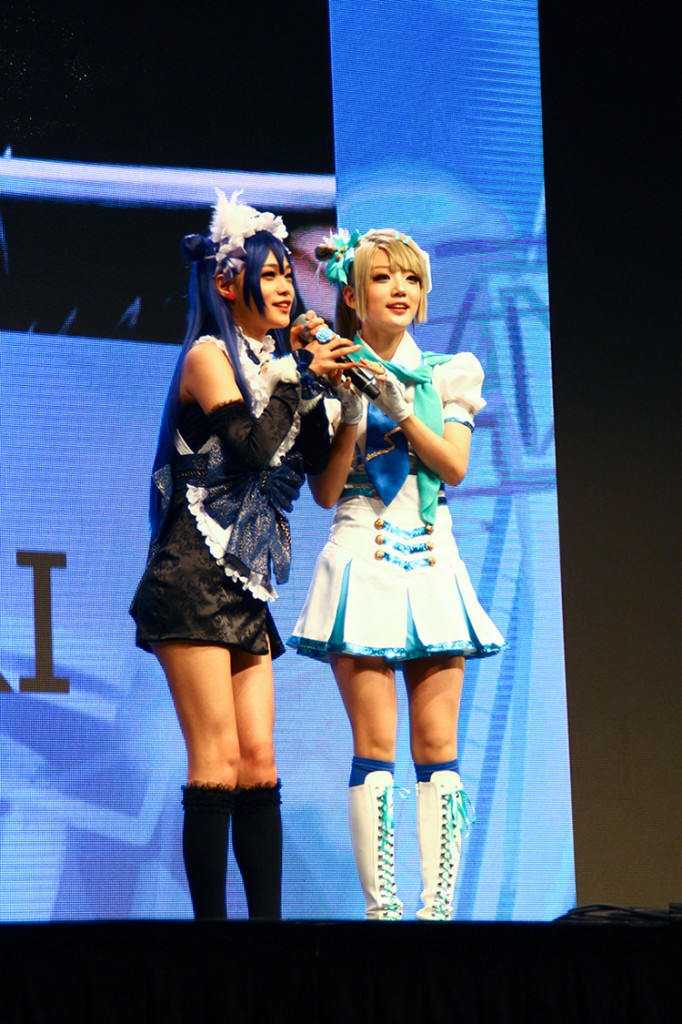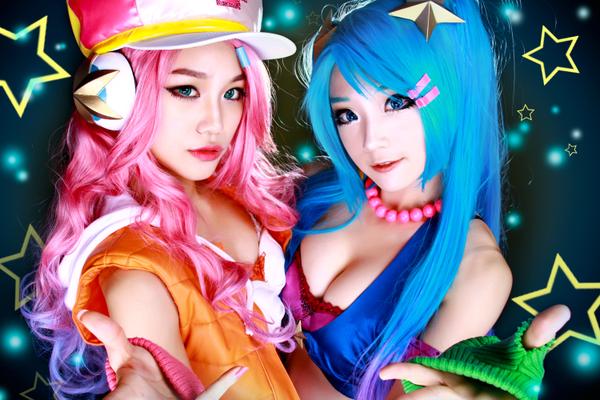- California Assembly OKs highest minimum wage in nation
- S. Korea unveils first graphic cigarette warnings
- US joins with South Korea, Japan in bid to deter North Korea
- LPGA golfer Chun In-gee finally back in action
- S. Korea won’t be top seed in final World Cup qualification round
- US men’s soccer misses 2nd straight Olympics
- US back on track in qualifying with 4-0 win over Guatemala
- High-intensity workout injuries spawn cottage industry
- CDC expands range of Zika mosquitoes into parts of Northeast
- Who knew? ‘The Walking Dead’ is helping families connect
Aza and Hori: Rising stars of S. Korean cosplay world

Aza, left, and Hori, right, attend a fan signing event at Anime Expo 2015 inside the Los Angeles Convention Center. (Photo courtesy of 2AO Design)
By Tae Hong
LOS ANGELES — Downtown Los Angeles crawled with magicians, schoolgirls, titans, heroes and furry warrior animals of every possible color, scepters and wigs and wands and capes blazing trails through a packed convention center, in early July.
Two rising stars from South Korea’s cosplay scene — Aza, 24, and Hori, 26 — were greeted as guests by a sea of cosplayers and anime enthusiasts at Anime Expo as they participated in meet-and-greets.
Under 2AO Design, a workshop founded by Kim Hyung-sun about three years ago, Aza (Kang Yoon-jin) and Hori (Jang Seo-mi) transform into a catalogue of anime and video game characters on what they say is still a semi-professional level.
Others may disagree with that label — last year, Aza was chosen as the Korean representative at the World Cosplay Summit and awarded Samsung’s People’s Choice award.
In glitter-eyed costume as Minami Kotori and Umi Sonoda from anime “Love Live!”, the pair sat down with the Korea Times to dish about attending their first-ever U.S. event at the largest anime gathering in the country.
“We have never been to an event as big as this,” Hori said. “I’m excited and happy to see so many people here who love animation culture.”
“In Korea, people follow a trend and mostly cosplay the same characters, so I’m surprised to see such a diverse set here,” Aza said. “It’s so interesting to see people dressed as characters they really like. As a Korean person, it’s admirable.”
Aza and Hori started cosplay around the same time about a decade ago. They didn’t know each other at the time, but both grew up anime enthusiasts.
Cosplay was another world — for Aza it was a festival at her middle school and ensuing membership in a cosplay club; for Hori it was Comic World Seoul, one of the country’s largest such events, when she was 15.
“I went with friends to the convention, and the cosplayers there struck me as so cool, so surprising, so new,” Hori said. “I wanted to try it, too.”
Cosplay, a blend of the words “costume” and “play,” is essentially character dress-up taken to the next level. (As in, these aren’t your typical Halloween costumers. No one would be caught dead fooling around with plastic bags and toilet paper here.) Cosplayers like Aza and Hori have teams dedicated to recreating them as certain fictional personas with attention to the smallest details, from cuffs to make-up to fabric material.
They’re costume makers before they’re in-the-flesh characters. They were amateurs once, too, and making the outfit’s half the battle. The pair calls themselves perfectionists when it comes to quality.
Still, costume play’s never enjoyed status as a mainstream hobby in Korea. Fortunately for the thousands who indulge in the hobby, things are getting much, much better.
“At the beginning, I used to hear a lot of harsh cursing directed at cosplayers,” Aza said. “But at one point, people began seeing cosplay as its own culture.”
“She’s right,” Hori said. “In the past, I was afraid of people’s perceptions.”

Hori, left, and Aza, right, attend Anime Expo 2015 inside the Los Angeles Convention Center. (Photo courtesy of 2AO Design)
Cosplay is self-reinvention for the girls, who readily admit that one of their favorite aspects of becoming other people is getting to wear beautiful, out-of-the-world clothing.
“I usually don’t wear make-up or dress in flashy clothes,” Aza said. “But when I find a character I want to cosplay, it’s different. I want people who see me to say, ‘She looks exactly like that character.’ So I do my best to hear that.”
Hori, who described herself as “shy,” said she breaks out of her shell the second the outfit is on.
“When I cosplay, the way I approach people changes,” she said. “I think it takes courage to do this, to put yourself in atypical clothes.”
2AO costumes are made by a close-knit team led by Kim, who said the company is currently working on a new project that hopes to jolt Korea’s cosplay scene with special-effects outfits that have not yet been attempted among the country’s enthusiasts.
“This company was started by myself and a school friend of mine,” Kim said. “To call us a professional cosplay team is still too much. We do this because we like cosplay, and because of our passion for it.”
The sentiment hasn’t gone unnoticed.
“People have come up to me to say I changed their image of cosplayers,” Aza said. “That gives me not just confidence, but hope.”

















Pingback: How To Color Anime Clothes In Sai | Fix How To